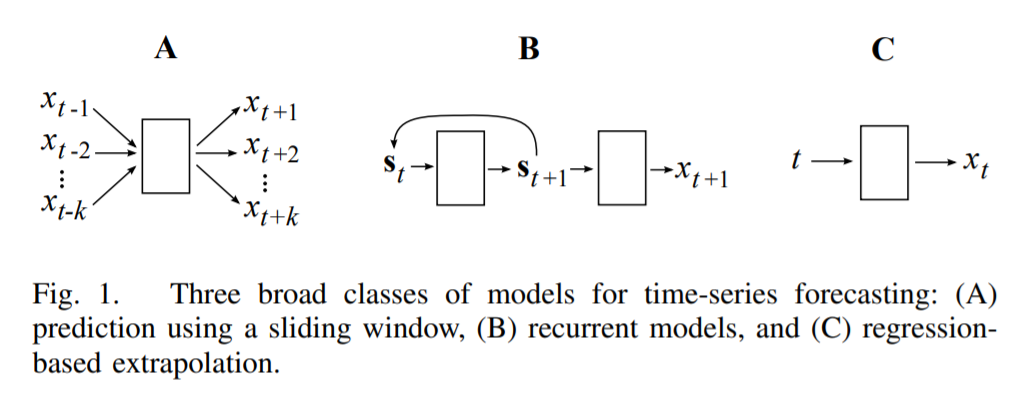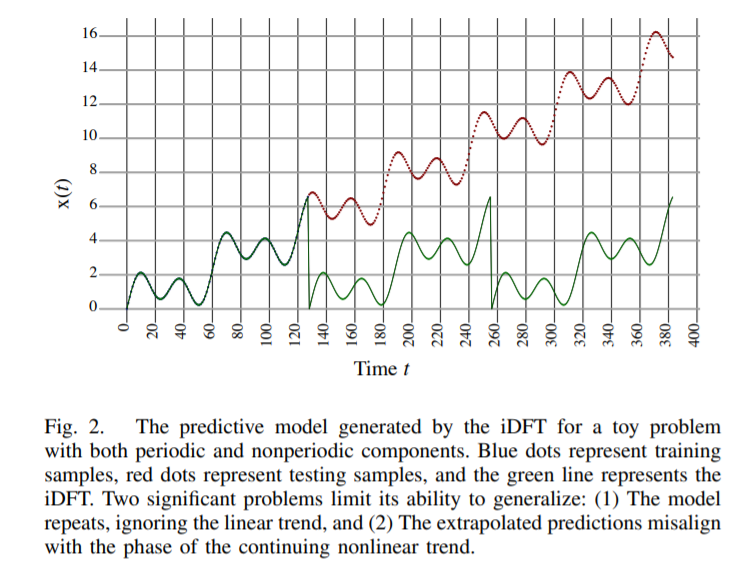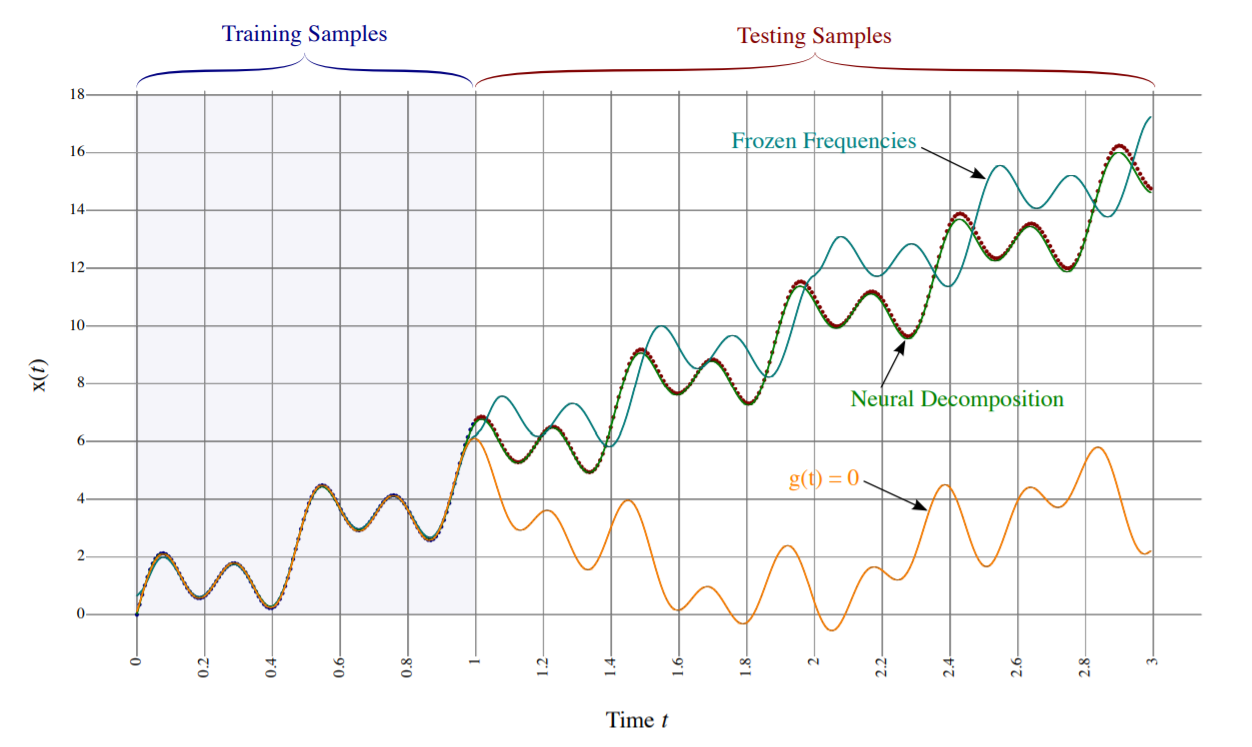Neural Decomposition of TD data for Effective Generalization (2017,40)
Contents
- Abstract
- Introduction
- Related Works
- Models for TS prediction
- Harmonic Analysis
- Fourier NN
- Neural Decomposition
0. Abstract
Neural Decomposition (ND)
-
NN for “analysis” & “extrapolation” of time-series data
-
use 2 kinds of units
-
1) Units with “sinusoidal activation function”
( perform Fourier-like decomposition )
-
2) Units with “non-periodic activation function”
( to capture linear trend & other non-periodic components )
-
1. Introduction
Analyzing time series data 2 ways :
[ approach 1 ] interpretation
interpret TS as a signal & apply Fourier transform to decompose it into a sum of sinusoids
-
Fourier transform = uses a pre-determined set of sinusoid frequencies ( DO NOT LEARN )
\(\rightarrow\) effective at interpolation, but bad at extrapolation
[ approach 2 ] regression & extrapolation
use models, such as NN
-
Fourier NN : “sinusoidal activation functions”
\(\rightarrow\) but, difficult to train
-
RNN : difficulty in handling unevenly sampled TS
Proposal : ND
effective generalization can be achieved by…
- regression & extrapolation, using a model with 2 properties!
2 properties
- 1) combine both PERIODIC & NON-PERIODIC components
- 2) must be able to TUNE its components & weights ( = learnable )
Neural Decomposition (ND)
- 1) like Fourier Transform….
- decompose signal into sum of constituent parts
- 2) unlike Fourier Transform….
- able to reconstruct a signal “that is useful for extrapolating”
- does not require the number of samples to be a power of two
- does not require that samples be measured at regular intervals
- 3) includes “non-periodic” components
- ex) linear, sigmoidal components
- account for trends & non-linear irregularities
2. Related Works
(1) Models for TS prediction

ND falls into (C) regression-based extrapolation
-
fit a curve to a data & predict new data using the trained curve
-
advantage over RNN
- can make continuous predictions
-
closely related to Fourier NN
( due to its use of “sinusoidal activation functions” )
(2) Harmonic Analysis
Harmonic Analysis of signal
( = Spectral analysis, Spectral density estimation )
- transform a set of samples from “TIME” domain \(\rightarrow\) “FREQUENCY” domain
- Interpolation & Extrapolation
- ( interpolation ) able to reconstruct the original signal
- ( extrapolation ) able to forecast values beyond the sampled time window
- ex) DFT (Discrete Fourier Transform)
DFT & iDFT
-
( DFT ) time \(\rightarrow\) frequency
- use “negative multiples of \(2\pi / N\)” as frequencies
-
( iDFT ) frequency \(\rightarrow\) time
- can be used as a continuous representation of the originally discrete input
- use “positive multiples of \(2\pi / N\)” as frequencies
- contains normalization term \(1/N\)
-
written as a sum of \(N\) complex exponentials
( in terms of sines & cosines )
iDFT
Notation
- \(R_k\) : “REAL” components of \(k\)th complex number, returned by DFT
- \(I_k\) : “IMAGINARY” components of \(k\)th complex number, returned by DFT
- \(2\pi k /N\) : “frequency” of \(k\)th term
- first frequency ( \(k=0\) ) : bias ( \(\because\) \(cos(0)=1\), \(sin(0)=0\))
- second frequency ( \(k=1\) ) : single wave
- third frequencey ( \(k=2\) ) : two waves
- …
- cosine with \(k\)-th frequency : scaled by \(R_k\)
- sine with \(k\)-th frequency : scaled by \(I_k\)
Summary :
-
sum of \(N/2 +1\) terms, with \(sin(t)\) & \(cos(t)\) in each term
-
\(x(t)=\sum_{k=0}^{N / 2} R_{k} \cdot \cos \left(\frac{2 \pi k}{N} t\right)-I_{k} \cdot \sin \left(\frac{2 \pi k}{N} t\right)\).
\(\rightarrow\) useful as a “continuous representation” of the real-valued discrete input
Problem :
- iDFT assumes …. \(x(t+N)=x(t)\) for all \(t\)
- cannot effectively model the “non-periodic components of a signal”

(3) Fourier NN
Fourier NN = NN that use a Fourier-like neuron
- case 1) input = Fourier transform of some data
- case 2) weight = Fourier transform
3. Neural Decomposition
describe ND (Neural Decomposition) for analysis & extrapolation of TS data
- allow sinusoid frequencies to be TRAINED
- augment the sinusoids with a NON-PERIODIC FUNCTION, to model non-periodic components
Notation
-
\(a_k\) : amplitude
-
\(w_k\) : frequency
-
\(\phi_k\) : phase shift
-
\(g(t)\) : augmentation function
( = represents the non-periodic components of the signal )
Model
- \(x(t)=\sum_{k=1}^{N}\left(a_{k} \cdot \sin \left(w_{k} t+\phi_{k}\right)\right)+g(t)\).
- comparison with iDFT
- (1) \(k=0\) \(\rightarrow\) \(k=1\)
- no need for bias term ( now, we have \(g(t)\) )
- (2) \(N/2\) \(\rightarrow\) \(N\)
- \(N/2\) sines & cosines each \(\rightarrow\) \(N\) sines only
- (1) \(k=0\) \(\rightarrow\) \(k=1\)


